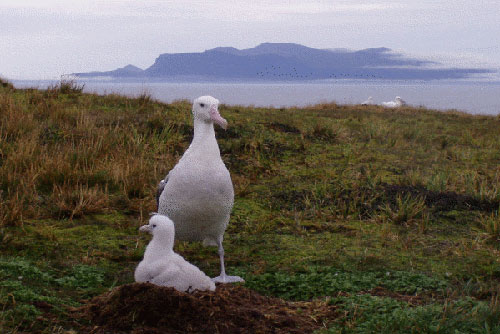South Africa's Prince Edward Islands in the southern Indian Ocean are an important locality for a total of nine regularly breeding ACAP-listed species. The results of a recent survey of the seven surface-nesting ACAP species have now been published in the African Journal of Marine Science. The full abstract follows below.

The second mid-summer survey of surface-nesting seabirds at the Prince Edward Island group (Marion and Prince Edward islands) was conducted during December 2008, seven years after the initial mid-summer survey. Wandering Albatrosses Diomedea exulans may have decreased slightly at Prince Edward Island, mirroring a decrease of roughly 2% per year at Marion Island from 1998 to 2005, a decline that has since reversed. Numbers of Grey-headed Albatrosses Thalassarche chrysostoma on Marion Island have remained stable, whereas the population on Prince Edward Island decreased by 20% from 2001 to 2008 (3% per year). The estimate of Indian Yellow-nosed Albatrosses T. carteri at Prince Edward Island was similar in 2001 and 2008. Counts of both sooty albatrosses Phoebetria spp. were substantially higher at Prince Edward Island in 2008, possibly as a result of better coverage compared to 2001. Sooty Albatrosses P. fusca on Marion Island have decreased by almost 2% per year since 1996, continuing a negative trend from the early 1980s, whereas Light-mantled Sooty Albatrosses P. palpebrata have increased by almost 6% per year at Marion Island since 1996. Counts of both giant petrels increased at Prince Edward Island (Northern Macronectes halli by 44%; Southern M. giganteus by 28%), whereas their numbers have remained stable at Marion Island. Current best estimates for annual breeding populations (pairs) at the two islands are 3650 Wandering Albatrosses, 9500 Grey-headed Albatrosses, 7000 Indian Yellow-nosed Albatrosses, 2900 Sooty Albatrosses, 800 Light-mantled Sooty Albatrosses, 750 Northern Giant Petrels and 2800 Southern Giant Petrels, confirming the global importance of the Prince Edward Islands for these seven species. Apart from the Sooty Albatross, their populations are reasonably healthy despite fishing mortality.
Reference:
Ryan, P.G., Jones, M.G.W., Dyer, B.M., Upfold, L. & Crawford, R.J.M. 2009. Recent population estimates and trends in numbers of albatrosses and giant petrels breeding at the sub-Antarctic Prince Edward Islands. African Journal of Marine Science 31: 409-417. http://www.nisc.co.za/oneAbstract?absId=3305.
Click here and here for abstracts of papers on the previous survey of surface-nesting ACAP species at the Prince Edward Islands, conducted in 2001.
John Cooper, ACAP Information Officer, 25 December 2009

 English
English  Français
Français  Español
Español